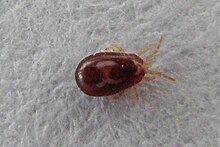Red mite
| Dermanyssus gallinae | |
|---|---|
 |
|
| Scientific classification | |
| Kingdom: | Animalia |
| Phylum: | Arthropoda |
| Class: | Arachnida |
| Subclass: | Acari |
| Order: | Mesostigmata |
| Family: | Dermanyssidae |
| Genus: | Dermanyssus |
| Species: | D. gallinae |
| Binomial name | |
|
Dermanyssus gallinae (De Geer, 1778) |
|
| Dermanyssus gallinae | |
|---|---|
| Classification and external resources | |
| Specialty | infectious disease |
| ICD-10 | B88.0 (ILDS B88.060) |
Dermanyssus gallinae (also known as the red mite, poultry mite, red poultry mite, roost mite and chicken mite) is an ectoparasite of poultry and other bird species.
The mites are blood feeders and attack resting birds at night. They are generally white or greyish in colour, becoming darker or redder when engorged with blood. After feeding, they hide in cracks and crevices away from daylight, where they mate and lay eggs. The mite progresses through 5 life stages: egg, larva, protonymph, deutonymph and adult. Under favourable conditions this life cycle can be completed within seven days, so populations can grow rapidly - causing anaemia in badly affected flocks of poultry. Young birds are most susceptible. The mites can also affect the health of the birds indirectly, as they may serve as vectors for diseases such as Salmonellosis, avian spirochaetosis and Erysipelothrix rhusiopathiae.
The mites normally feed around the breast and legs of hens, causing pain, irritation, and a decrease in egg production. Pustules, scabs, hyperpigmentation and feather loss may develop.
If they are present in large numbers, D. gallinae can cause anemia in hens which presents as pallor of the comb and wattle.
A presumptive diagnosis can be made in flocks of laying hens, usually based on a history of decreasing egg production, anaemia and mortalities in young or ill birds. Blood spots on eggs indicate infestation within the cloaca of an affected hen. Definitive diagnosis is only achieved following identification of eggs, feces or the mites themselves.
Predatory mites and ectoparasiticides can be used to treat affected poultry. Predatory mites are sold and distributed internationally and throughout the United States as an effective solution. Amblyseius andersoni is an effective predatory mite for target pests including red mites. For ectoparasiticides, these chemical controls, if used, should be used in rotation to avoid the buildup of resistance. Red mites can survive for up to 10 months in an empty hen house. Creosote treatment of wood will kill mites. Prevention of infestation in a human habitation consists of eliminating vectors (pigeons in eaves, infested backyard poultry, etc.). Elimination of an infestation in a human habitation is best achieved through a combination of eliminating potential vectors (nesting pigeons, backyard poultry, etc.); reducing potential hiding places (rugs, clutter); judicious use of pesticides; consistent use of dehumidifiers to maintain a low humidity environment; maintaining a low temperature in the environment; frequent thorough cleaning; minimizing the amount of time spent in the home; and maintaining excellent hygiene and exercise habits. Treatment of infestation may require topical and oral medication such as ivermectin and may require several months to eradicate.
...
Wikipedia
